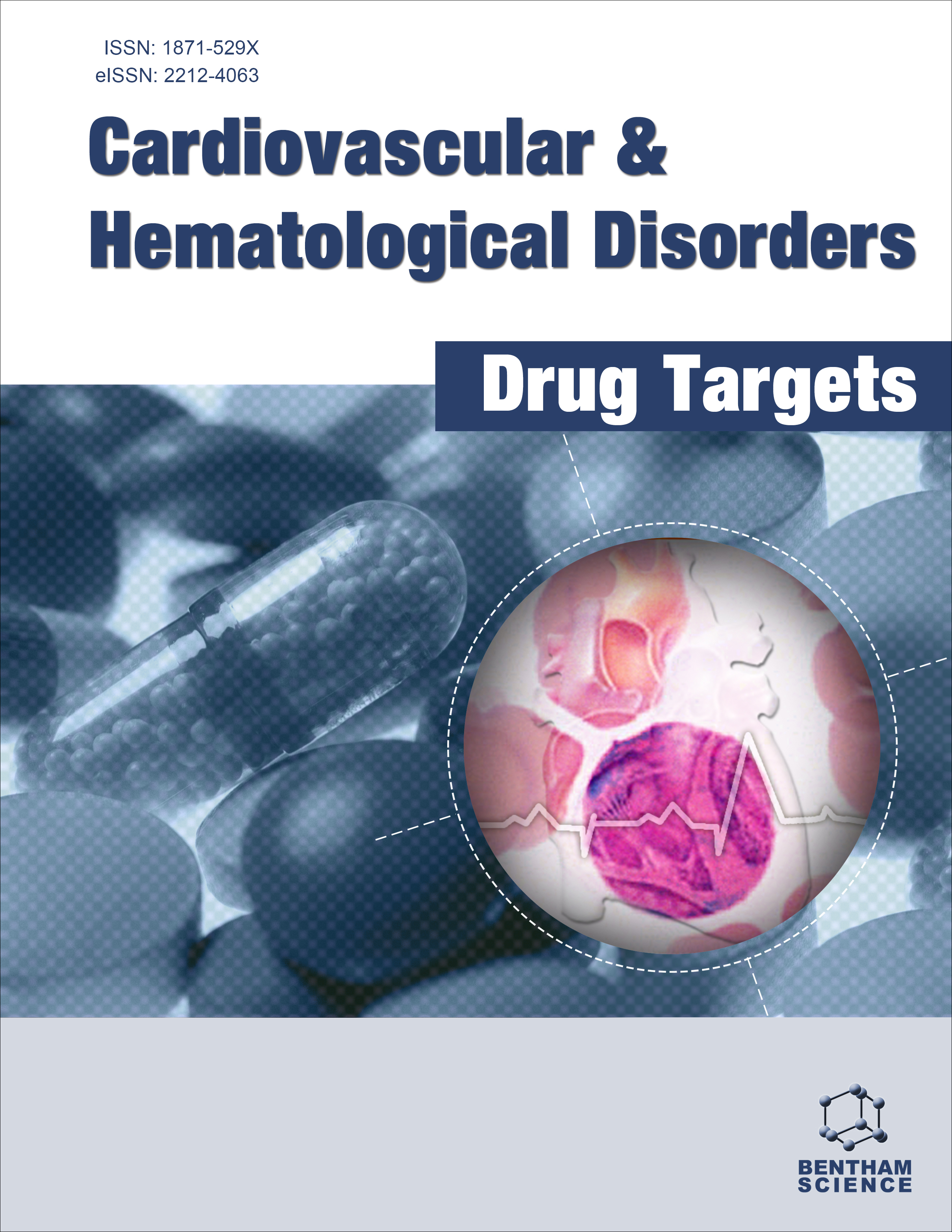- Home
- A-Z Publications
- Cardiovascular & Haematological Disorders - Drug Targets
- Previous Issues
- Volume 13, Issue 1, 2013
Cardiovascular & Haematological Disorders - Drug Targets - Volume 13, Issue 1, 2013
Volume 13, Issue 1, 2013
-
-
Novel Targeted Therapies and Combinations for the Treatment of Multiple Myeloma
More LessAuthors: Amit Agarwal and Daruka MahadevanMultiple myeloma is a B-cell neoplasm that is characterized by clonal proliferation of terminally differentiated plasma cells. Approximately 20,000 new cases are diagnosed each year with a prevalence of about 60,000. Characteristic clinical features include bone disease, hypercalcemia, renal disease, anemia and infections. Advancements in our understanding of multiple myeloma have led to a significant impact in the natural Read More
-
-
-
Targeting of NF-kappaB Signaling Pathway, other Signaling Pathways and Epigenetics in Therapy of Multiple Myeloma
More LessBy Ota FuchsMultiple myeloma (MM) remains an incurable disease, at least for the big majority of patients, in spite of the great progress with new drugs in the last years. New treatment strategies are needed to improve the outcome of patients. NF-κB activation in MM is caused by mutations in the factors involved in the NF-κB pathways contributing to their dysregulation and by signals from the bone marrow microenvironment. Agents with Read More
-
-
-
Outcomes of Patients with Chronic Heart Failure and Iron Deficiency Treated with Intravenous Iron: A Meta-analysis
More LessAuthors: Mahim Kapoor, Mark D. Schleinitz, Anthony Gemignani and Wen-Chih WuBackground: Trials studying iron repletion in patients with chronic heart failure (CHF) and iron deficiency are underpowered to find consistent hard endpoint (mortality and hospitalization) reductions. We conducted a meta-analysis of controlled trials to examine the effects of iron repletion on these parameters. Methods and Results: Pubmed, CENTRAL, EMBASE and NIH Clinical Trials databases were searched for controlled trial Read More
-
-
-
The Effect of Lead Exposure on Selected Blood Inflammatory Biomarkers in Guinea pigs
More LessThis study was aimed to examine the effect of lead acetate on inflammatory biomarkers in blood of guinea pigs in comparison with sensitized animals. Thirty guinea pigs were randomly allocated into control (group C), sensitized (group S), and three Pb-exposed (groups 0.1M Pb, 0.2M Pb and 0.4M Pb). Animal sensitized after aerosolized-ovalbumin (OA) challenge. Pb-exposed groups inhaled 0.1M, 0.2M and 0.4M lead aceta Read More
-
-
-
Fc-independent Phagocytosis: Implications for IVIG and other Therapies in Immune-mediated Thrombocytopenia
More LessPhagocytes were first described by Dr. Metchnikoff in 1873. The roles of phagocytes in innate and adaptive immunity have been well established to date, although the molecular mechanisms involved in initiating phagocytosis (through Fc or other receptors) remain to be further explored. Phagocytes in the reticuloendothelial system, particularly macrophages, have been implicated in the clearance of senescent blood cells. Read More
-
-
-
Modulation of Cardiovascular Function by Adipokines
More LessAuthors: V. DeClercq, J. E. Enns, A. Yeganeh, C. G. Taylor and P. ZahradkaCardiovascular disease (CVD) and associated risk factors such as obesity remain at the forefront of health concerns. Adipose tissue has been well established as an endocrine organ that becomes dysfunctional with increased adipose tissue mass. The secretion of several adipokines is altered in subjects with abdominal adiposity and these changes to the endocrine balance may contribute to increased CVD risk. The identification Read More
-
-
-
Glucose-6-Phosphate Dehydrogenase Deficiency: Disadvantages and Possible Benefits
More LessAuthors: Genesia Manganelli, Ugo Masullo, Stefania Passarelli and Stefania FilosaWe review here some recent data about Glucose-6-phosphate dehydrogenase (G6PD), the housekeeping X-linked gene encoding the first enzyme of the pentose phosphate pathway (PPP), a NADPH-producing dehydrogenase. This enzyme has been popular among clinicians, biochemists, geneticists and molecular biologists because it is the most common form of red blood cell enzymopathy. G6PD deficient erythrocytes do Read More
-
-
-
Updated Role of Nitric Oxide in Disorders of Erythrocyte Function
More LessAuthors: Marc J. Kahn, Jason H. Maley, George F. Lasker and Philip J. KadowitzNitric oxide is a potent vasodilator that plays a critical role in disorders of erythrocyte function. Sickle cell disease, paroxysmal nocturnal hemoglobinuria and banked blood preservation are three conditions where nitric oxide is intimately related to dysfunctional erythrocytes. These conditions are accompanied by hemolysis, thrombosis and vasoocclusion. Our understanding of the interaction between nitric oxide, he Read More
-
Volumes & issues
-
Volume 24 (2024)
-
Volume 23 (2023)
-
Volume 22 (2022)
-
Volume 21 (2021)
-
Volume 20 (2020)
-
Volume 19 (2019)
-
Volume 18 (2018)
-
Volume 17 (2017)
-
Volume 16 (2016)
-
Volume 15 (2015)
-
Volume 14 (2014)
-
Volume 13 (2013)
-
Volume 12 (2012)
-
Volume 11 (2011)
-
Volume 10 (2010)
-
Volume 9 (2009)
-
Volume 8 (2008)
-
Volume 7 (2007)
-
Volume 6 (2006)
Most Read This Month
Article
content/journals/chddt
Journal
10
5
false
en


